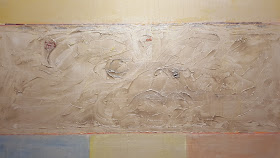My recent visit to Tate Modern's Soul of a Nation:Art in the Age of Black Power exhibition was quite an eye opener. Not only did it tell the story of the civil rights struggle in 60s/70s America eloquently, passionately, and prismatically through the art of the era, also it introduced me to a long list of artists I'd hitherto been either only vaguely aware of or completely ignorant of.
One of those artists was the Guyanese Frank Bowling. The two works, Middle Passage and Texas Louise, that'd been included in the Tate show took inspiration from abstract expressionism and Robert Rauschenberg but used those as launch pads to explore notions of identity, rootlessness, and the black experience as and of itself and as part of the wider experience of living in a 20th century dominated by US power.
It's surely no coincidence that Shoreditch's Hales Gallery's Frank Bowling:Fishes, Wishes in Summertime Blue had been programmed to overlap with the Tate blockbuster. In fact the practice of the small commercial galleries following the lead of the big organisations just serves to underline how vital it is that the Tate, the Royal Academy, the National Gallery etc; are braver and more diverse with their programming. Of late the Tate has definitely been leading the way on this front with recent shows devoted to female Turkish abstraction, the under rated Cuban artist Wifredo Lam, and the colourful, figurative Indian artist Bhupen Khakhar.
Many of the artists included in the Soul of a Nation show would be worthy of their own large scale retrospective and, hopefully, one day some of them will receive that. For now though, we've a chance to see what Frank Bowling's been doing in the last few years. The Hales show is small, just one room with eight large canvases on the walls, but is worth half an hour of your time.
Iona Miriam's Christmas Visit To & From Brighton (2017)
Bowling was born in 1936 in the Cuyuni-Mazuruni region of then British Guiana to a police district paymaster father and a seamstress mother. At the age of 15 he moved to England, completed his education, did his National Service with the Royal Air Force, before giving up early ambitions to become a poet or writer to focus on the visual arts.
He studied at the Chelsea School of Art and the Royal College of Art. Fellow students included David Hockney, R.B.Kitaj, Allen Jones, and Derek Boshier. On graduation in 1962 Hockney controversially beat Bowling to the gold medal. Bowling had been relegated to silver because he'd married Paddy Kitchen. Kitchen was staff and Bowling was a student and such liaisons were frowned upon if not, clearly, completely verboten.
Stuart's Prediction (2016)
Pouring Over 2 Morrison Boys & 2 Maps II (2016)
Moving to New York in the mid-sixties saw Bowling and his art blossoming. Moving away from his peers and Francis Bacon inspired figurative painting he, with the encouragement of influential critic and essayist Clement Greenberg, drew upon the art of Jackson Pollock, Mark Rothko, and Barnett Newman but fused their work with his own more personal and political themes, often to great acclaim.
Always interested both in the idea of home and the very concept of belonging Bowling's recent work uses generous blues and greens to evoke the imagery of forests and rivers but there's also an element of paint for paint's sake about it. Some of the paint is layered on so thickly that like, for instance Frank Auerbach, it almost demands you touch it. I had a cheeky feel when nobody was looking.
Ashton's Swirl I (2016)
Little Bird Overhead (2016)
The titles of the paintings on show are nothing if not a little abstruse. Many of them refer back to previous work in Bowling's oeuvre (Pouring Over 2 Morrison Boys & 2 Maps II) or even events from his personal life (Iona Miriam's Christmas Visit To & From Brighton) so it's difficult to ascertain any meaning from them. That's less of a problem than you might think as it means you can simply enjoy the work for what it is. Bowling had spoken about the expectations heaped upon him as a black, post-colonial painter and in this exhibition we can see how he's freed himself from the yoke of presumption and allowed his art to reach out in hope to the future.
Shadowbalding (2014)
Horsing Around (2016)
Works like Little Bird Overhead, Shadowbalding, and especially my favourite Collaboration with Ms & Damidge show that Bowling, like Pollock, revels in the physicality of paint and painting and at the age of 81 shows no signs yet of relenting. Often as we reach more advanced ages we find joy in the more simple, quotidian aspects of life. I visited my nan recently and her greatest pleasures now seem to be a smile, a touch, or a kiss. My nan's got twelve years on Bowling but he too has moved on to a different plateau. No longer does he need art to tell a political story. He's been there and done that better than most. Now he's earned the right to paint what he likes and call it what he likes. He's earned the right to celebrate colour for colour's sake and to bathe in the warm glow of both his art and his creation. I'd give him a smile and a hug for that.
Collaboration with Ms & Damidge (2016)








No comments:
Post a Comment